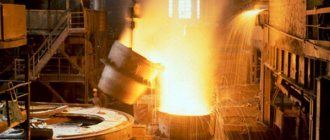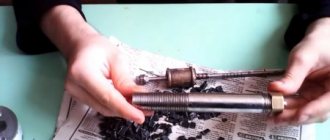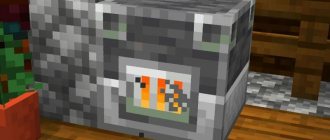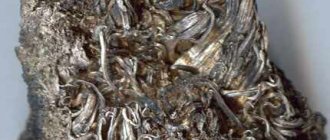Lost wax casting
Investment casting allows the production of precision components, minimizing material waste, reducing the energy intensity of production and reducing the cost of subsequent processing of finished castings, and of any degree of complexity.
Lost wax casting technology uses a shell of ceramic, plaster or plastic that is formed around a wax mold. This mold is then melted and removed in a furnace and the metal is poured into the shell to create the casting.
The lost wax casting process occurs in several stages:
- Creation of an initial sample that reflects the configuration of the finished part, adjusted for thermal shrinkage of the workpiece;
- Making wax samples and creating a wooden model. It is assembled in such a way as to ensure delivery of the melt to all hard-to-reach parts of the casting;
- Creating a mold shell, where the entire wax model is dipped into a ceramic slurry, covered with a sand shell and sent to dry. These cycles are repeated until a shell of the desired thickness is created, which is set to the dimensions and configuration of the finished casting. Once the ceramic shell dries, it is strong enough to hold the molten metal during casting.
- Removal of wax, for which the entire assembly is placed in a steam autoclave to melt almost all the wax (the remains, impregnated with ceramic composition, are burned in the oven). Then the sprues are also removed;
- Melting and casting. The mold is preheated to a certain temperature and filled with molten metal, creating a metal casting. The lost wax casting process can produce a finished product from any alloy. Depending on its chemical composition, melting in air or vacuum can be used. Vacuum melting is used when reactive elements are present in the alloy.
- Final operations. After the casting has completely cooled, the mold shell is separated from the casting by displacement. In this case, the remains of the channels and sprues are cut off, and, if necessary, sandblasting, grinding and mechanical finishing of the casting are performed to the dimensions specified in the product drawing.
The technology includes a non-destructive testing stage, for which fluorescent, magnetic particle, radiographic or other quality control methods are used.
Advantages of the method:
- A wide range of masses of the resulting castings - from small to 300...350 kg.
- Versatility and complexity of shape, including those that cannot be obtained by metal-cutting on machines.
- Minimization of subsequent mechanical finishing.
- High precision and low roughness of the finished surface.
Investment casting is a good alternative to welding because many components can be combined into one complex-shaped casting.
Since the tool is quite complex to manufacture, this technology fully pays for itself in serial and mass production.
Types of molding
They are determined by the type of model and the chosen casting method.
According to a simple model
The model is placed face up on the board. Center it relative to the flask. Cover with a facing mixture, then add filler in layers, carefully compacting each layer. Add soil to the flask until it is filled. Having removed the upper flask, take out the model and create a gating system. The flasks are collected together, secured and dried.
According to split model
The method significantly simplifies the technology and increases the accuracy of manufacturing the casting mold. A part of the model without spikes is placed on the board, the lower flask is installed and the ground is shaped. Upon completion, the structure is turned over, the second part is attached to the model, the upper flask is attached and it is stuffed.
With false cover
For particularly complex product geometry, I use false pins. It does not come into contact with the melt, but plays the role of a figured fake board.
Forming methods
Lumpy
It is used for artistic casting, especially sculptural compositions. The model is furnished with several independent flasks, their edges touching. Sometimes a casting is divided into segments that are relatively simple in configuration, they are modeled and cast independently, and then the finished castings are connected.
Template
It is produced by casting products of a certain shape into the ground. Distinguish
- Bodies of rotation (cylindrical, conical and elliptical)
- Rectangular or prismatic.
The formation of the earth is carried out by a template of the appropriate configuration, driven by a powerful spindle for bodies of rotation or moving along special guides for prismatic shapes.
Die casting
All types of chill casting are a group of methods especially suitable for producing castings from non-ferrous alloys - aluminum, magnesium and brass. Before casting, the functional surfaces of the molds are treated with a special kaolin or similar coating, which will effectively separate the surfaces. Molds that cannot be removed from the mold are often made using sand cores. After casting, the cores are destroyed.
Compared to sand casting, the solidification of the mold occurs faster due to better thermal conductivity. A casting is formed with a relatively fine and dense material structure, which, at the same time, has better mechanical properties compared to a casting from the same material, but cast in a sand mold.
Advantages of die casting:
- due to faster solidification, chill casting has better mechanical properties and a relatively fine and dense material structure;
- slight surface porosity;
- high dimensional accuracy and reduced surface roughness;
- reduction of metal loss coefficient.
Chill casting is a good choice for producing medium-sized castings for runs of 1,000 to 10,000 pieces, with a minimum production run of 100 pieces.
The process is used to produce medium-sized castings of instrument housings, drive covers, racks, brass or steel sealing inserts (nuts, bearing housings, pins, etc.).
Under pressure
Injection molding is a manufacturing process adapted for the production of parts in high volumes. The casting mold includes a sprue channel through which the molten material exits the nozzle of the injection molding machine. The mold has a system of channels that connect to the sprue (usually inside or as part of the mold) and direct the molten material into the mold cavity. The part of the channel after the slider, called the gate, leads directly into the tool cavity. After the injection mold cycle (usually lasting only a few seconds), the entire melt is cooled, leaving a solidified casting in the sprue, runners, and mold cavity.
The main advantage of the injection molding method is the ability to mass produce castings. The initial costs of implementation and development of production are quite high, but subsequently the cost per unit of production becomes extremely low.
Other benefits of the process:
- low defect rate (compared to traditional production processes, including CNC machining);
- reduction of production waste due to small losses of metal in the sprues, guides, and the location of holes for the melt outlet;
- possibility of producing parts from thermosetting plastics.
Injection molding can be reproduced in any volume, since the durability of the molds is very high. This ensures uniform quality of castings and stability of their characteristics during large-scale production.
Injection molding technology virtually eliminates any modification of the shape of finished products.
Metalworking parts
Milling and turning works. Takes on average 2 weeks.
The cost of aluminum plates is higher than steel
| Metalworking Moscow | Address | Telephone | Milling | Assembly | |
| Tsvetmet | Arbatetskaya st., 2, building 21, Moscow | +7 | Not really | Yes / No | |
| Industrial construction | 2nd Perov Polya Ave., 5, Moscow | Not really | Yes / No | ||
| Unex | Vyatskaya st., 49, building 1, Moscow | +7,, +7 (495) 748-14-50 | Not really | Yes / No | |
| Cut Gear - CNC metalworking | Yeniseiskaya st., 1, building 3, Moscow | +7 | Not really | Yes / No | |
| Repair of levers | Russia, Moscow, South-Western administrative district, Yuzhnoye Butovo district, Projected passage No. 661 | +7 | Not really | Yes / No | |
| Stainless Metalservice | Izyumskaya st., 46, Moscow | +7 +7 | Not really | Yes / No | |
| Race-Lab | st. Pererva, 19, building 3, Moscow | +7 +7 | Not really | Yes / No | |
| StroyMontazhServis-M | Irkutskaya st., 11, bldg. 1, Moscow | +7 | Not really | Yes / No | |
| Company Modern Technologies | Bryanskaya st., 2, Moscow | +7 | Not really | Yes / No | |
| Surfox | Kutuzovsky Prospekt, 36, building 10, Moscow | +7 | Not really | Yes / No | |
| APS Radis | Sharikopodshipnikovskaya st., 4, Moscow | +7, | Not really | Yes / No | |
| Trust metal | Volokolamskoye sh., 73, Moscow | +7, | Not really | Yes / No | |
| Continental | 3rd Khoroshevskaya st., 11A, Moscow | +7 | Not really | Yes / No | |
| TD Sortprokat | st. Verkhnie Polya, vl18V, Moscow | +7 | Not really | Yes / No | |
| Wholesale/retail metal goods | Ugreshskaya st., 2, building 23, Moscow | +7 | Not really | Yes / No | |
| Santa M1 | Avtozavodskaya st., 25, Moscow | +7 | Not really | Yes / No | |
| StalKom Plus | Russia, Moscow, MKAD, 85th kilometer, external side | Not really | Yes / No | ||
| PKF Stroy Invest | Nizhegorodskaya st., 29-33с36, Moscow | +7 | Not really | Yes / No | |
| Steel production | Leninsky Prospekt, 42, bldg. 1, Moscow | +7 | Not really | Yes / No | |
| Tech Metal | Altufevskoe sh., 27A, building 1, Moscow | +7 +7 | Not really | Yes / No | |
| Sphere of groups | st. Borisovskie Ponds, 1, building 1, Moscow | Not really | Yes / No | ||
| Technological equipment and metalworking | Novodmitrovskaya st., 5A, building 1, Moscow | +7 | Not really | Yes / No | |
| Bonetti Opus Rus | Ryazansky Prospekt, 8A, building 24, Moscow | +7 | Not really | Yes / No | |
| First fastener plant | st. Vavilova, 69A, Moscow | 8 | Not really | Yes / No | |
| Profile | Kulakov lane, 6, Moscow | Not really | Yes / No | ||
| TPK K-Stroy | 1st Vyazovsky Ave., 4, bldg. 1, Moscow | +7 | Not really | Yes / No | |
| Trest Spetsmashmontazh No. 7 | Olonetsky Ave., 4, bldg. 2, Moscow | +7, +7 | Not really | Yes / No | |
| TC Stalintex Trade | Novosuschevskaya st., 19B, Moscow | 8,,, +7 (495) 649-83-00,,, +7 (499) 973-38-97,,, +7 (499) 973-25-47, | Not really | Yes / No | |
| GasSnabStroy | Dmitrovskoe sh., 163, building 6, Moscow | +7, | Not really | Yes / No | |
| Grund | Zeleny prosp., 3/10с15, Moscow | +7,, +7 (495) 232-91-85 | Not really | Yes / No |
Under regulated pressure
A type of injection molding that provides better process control. There are many factors that can affect the quality of the final product. The following variables play an important role in the controlled injection molding process:
- The rate at which molten metal is introduced into the mold cavity. It is important that the molten metal completely fills the cavity before it begins to solidify. If the metal flow rate is not ideal, it will negatively impact the strength of the final product.
- Injection pressure, which directly affects the rate at which molten metal enters the mold cavity. In controlled injection molding, the injection pressure is increased to improve sealing. A combination of high injection pressure and larger gate sizes is used to ensure structural stability of the casting. This in turn improves the overall mechanical properties of the casting, particularly the tensile strength.
- The time required for the molten metal to fill the cavity depends on the speed of the metal at the gate and the area of the gate. If the gate is large, the injection speed can be low, but if the gate is small, the injection speed must be high in order to completely fill the cavity.
For injection molding, alloys of metals and alloys are used, which are characterized by increased casting properties (fluidity).
An important factor affecting the castability of an alloy is the solidification interval. If the difference between the solid and liquid point of the alloy is large, controlled pressure casting is not used.
In shell forms
Shell casting is used to produce cylinder heads, connecting rods and other machine parts where increased precision is required. This process requires a sand mold, and a special type of resin-coated sand is used.
The process provides a number of advantages:
- the ability to create complex shapes with the highest precision;
- low labor costs;
- suitable for most metals and alloys;
- used for any scale of production;
First, the sand is thoroughly mixed with resin, which acts as a binder. Then the sand is poured into a heated mold, the temperature of which usually reaches 750...13000C. The heated mold initiates a reaction with the resin-coated sand. When sand comes into contact with a hot mold, a shell forms on the inner surface of the mold. Next, excess sand is removed from the mold, and then the shell itself is removed, for which ejector pins are used. The ejector is built into the mold itself, making it easy to remove the newly created shell without damaging it.
Properties of molding sands
The molding mixture is characterized by the following basic properties:
- Strength determines the ability of a form to maintain its configuration
- Plasticity - important to the ability of a shape to follow the outline and surface details of a model.
- Gas permeability. Coarse-grained compounds allow gases to pass through more easily.
- Fire resistance. The material must not melt or sinter, impairing the uniformity of the casting surface.
- Compliance
- Homogeneity. The homogeneity of the mixture guarantees the constancy of its properties in space.
- Thermal conductivity. High-quality material has low thermal conductivity. This prevents the casting layer adjacent to the mold from cooling too quickly, deteriorating its properties.
- Durability is especially important for reusable molds. For disposable forms, durability refers to the number of times the soil is reused after grinding and screening.
Properties of molding sands
For mixtures of different purposes, different properties come to the fore. Thus, for facing materials, ductility, fire resistance and thermal conductivity are important, while for filling materials, strength and gas permeability are more important.
Centrifugal casting
Centrifugal casting is a process that produces high-strength castings. This technology is chosen for products such as jet engine compressor housings, hydraulic wear rings, and many defense products.
The steps in the centrifugal casting process begin with pouring molten metal into a preheated die. The mold can be oriented along either a vertical or horizontal axis depending on the part configuration.
As the mold rotates while pouring molten metal, centrifugal force distributes the molten metal into the mold under pressure up to 100 times the force of gravity. The combination of this pressure, controlled solidification and secondary refining produces products of the highest quality.
As the mold begins to fill, the denser molten metal is pressed against the wall. Directional solidification of the strong metal occurs from the periphery of the mold towards the channel, while less dense material, including impurities, moves towards the inner diameter.
After the casting has hardened, the part is removed from the mold, and residual contaminants remaining on the surface of the casting are subjected to mechanical processing - cleaning.
A variant of the technology is centrifugal casting in a vacuum. It is used when part accuracy and control of atmospheric exposure are critical because some alloys, including nickel-cobalt alloys, are reactive to oxygen.
Important: Centrifugal vacuum casting provides very high reliability for products often used in the aerospace and military industries.
Materials used
The “Seven Ancients” is a list of iron, copper, tin, lead, silver, gold and mercury - humanity has been familiar with them for thousands of years. Precious metals were used to make jewelry, and the main material for artistic casting in the past was copper-based alloys. In modern times, cast iron and aluminum were added to them.
Artists throughout history have not limited themselves to the range of materials they can melt. For example, in the 19th century in Europe and Russia, products made of zinc and lead were popular, and modern sculptors often turn to stainless steel. But the classic materials for artistic casting, even today, are bronze and cast iron.
https://youtube.com/watch?v=GHBak_el3CU
Bronze alloys
Alloys of copper with some non-ferrous metals (lead, tin, aluminum, beryllium) without the presence of zinc and nickel are called bronze. Copper with large impurities of zinc is brass. The latter is used mainly for the manufacture of cabinet sculpture and expensive furniture and interior fittings. Tin bronze has remained unchanged for centuries as the main material for artistic casting of large and small forms. Its advantages:
- negligible shrinkage;
- high turnover;
- not susceptible to porosity when cooling;
- high thermal conductivity;
- strength;
- corrosion resistance;
- elasticity;
- weldability.
Bronze casting is one of the oldest arts. Its use in different parts of the ancient world was widespread: people cooked in bronze dishes, wore bronze jewelry, used bronze tools, and fastened their clothes with bronze buttons. This era is known for the amazingly high quality of execution and unprecedented artistic power of sculptures that have survived to this day. Since those times, the bronze foundry tradition began, which has long outlived its century with the same name. Of course, alloys have been improved throughout history, but most of the technological processes of artistic casting have remained unchanged.
Gray cast iron
Bronze and iron are perhaps the most important materials in human history. It is not for nothing that they gave names to two eras of technological evolution - the Bronze and Iron Ages. Since iron casting required higher temperatures and complex furnaces, mankind mastered iron smelting somewhat later than bronze. According to some information, cast iron was poured in China 2 thousand years ago. The first mass products made from it in Europe and Russia were cannon barrels and cannonballs in the 15th century.
The evolution of furnaces and energy-intensive fuels for them quickly made high temperatures accessible not only to the military industry. The artistic use of cast iron began around 1500 with the production of tiles for stoves, monuments and fountains. A powerful impetus for the popularization of cast iron in art was the rapid development of metallurgical technologies in the second half of the nineteenth century and the industrialization that followed these events.
To prepare the sculpture, gray cast iron with a high phosphorus content is used as the most inexpensive alloy of iron and carbon suitable for casting. Phosphorus improves fluidity - this helps the metal to completely fill the mold. The property of phosphorus to increase the fragility of iron for artistic casting is not important, as is the inherent porosity of gray cast iron. The material has another important property - the attractive appearance of the finished product.
According to gasified models
It is a technology for producing high-quality castings using an initial model (blank) obtained from a material that, when pouring molten metal into a mold, is saturated with released gases.
As a result of the action of high temperatures, which manifests itself during the process of pouring the melt into the mold, the model is first destroyed and then melted. Destruction products in a drop-like state are blown out by a continuous gas flow. In this case, in the processing zone, depending on the design of the installation, either negative pressure or vacuum is created. Under the influence of the pressure difference inside and outside the container, the vacated space is occupied by a metal melt, which recreates in detail the configuration and dimensions of the casting.
Electroslag casting
Are there any methods of metal casting that can rightfully be called modern? Electroslag casting. In this case, liquid metal is first obtained by exposing previously prepared raw materials to powerful electric arc discharges. The arcless method can also be used, when the iron melts from the heat accumulated by the slag. But the latter is affected by powerful discharges.
After this, the liquid metal, which has never come into contact with air throughout the entire process, enters the crystallization chamber, which also doubles as a casting mold. This method is used for relatively simple and mass castings, for the production of which many conditions do not need to be met.
Continuous casting
A process that allows metals and alloys to stretch, shape, and harden without having to interrupt the pour. At the same time, waste is reduced, the yield of finished products is increased, and the economic efficiency of production is improved.
Battery grids are manufactured using continuous injection molding. Using a water-cooled roller and mold system reduces the chance of impurities and provides a better thickness ratio.
Some disadvantages of the method
The disadvantage of this casting method is the fact that only those types of metals that are characterized by increased fluidity in molten form are suitable for it. For example, only injection molding is suitable for steel (more on this below), since this material does not have good fluidity at all. Under the influence of compressed air, even the most “ductile” steel grades take the required shape much better. The bad thing is that an ordinary mold simply won’t withstand such extreme production conditions and will fall apart. Therefore, we have to use a special production method, which we will discuss below.
Metal casting in CTS
The acceleration of the casting process led to the development of cold-hardening mixtures (CMC), which have become widespread. They have certain disadvantages. For example, some self-drying oils create a form that requires long drying periods, especially when air access is prevented. Urea-based synthetic resins, which are also designed for use as CTS, have very low breakdown temperatures, which in turn limits the versatility of the resulting form. Sand mixtures containing furan-based acid-curing resins (another but relatively new cold-curing binder) also have certain limiting characteristics. For example, they tend to cause the mold to stick to the casting, and the outgassing that normally accompanies pouring molten metal into molds becomes very pronounced and turbulent.
Modern CTS compositions are formed using binders containing at least one diphenylmethane ethoxylin resin or diphenol derivatives, to which at least one organic compound containing many reactive amino groups is added as a hardener.
Very good results are obtained when ethoxylin resins are synthesized from para-substituted diphenylmethane derivatives, especially bisphenol. Moreover, their epoxy equivalent exceeds 170.
Among the organic compounds that can be used as hardeners, promising compositions are those having many reactive amino groups and especially polymers (linear or ring), which include from two to five = NCH CH groups.
A little history
The most important feature of iron, when it solidifies, to take the form “proposed” to it, was noticed by man back in ancient times. Today, almost all scientists assume that man’s initial acquaintance with metal took place thanks to meteorites. Meteoric iron was fusible and easy to process, so some nascent civilizations had been studying the basics of casting for a very long time.
In our country, metal casting has been a respected and honorable business from time immemorial; people have always treated this craft with great respect. The “Tsar Cannon” and “Tsar Bell” are widely known, being masterpieces of Russian foundry craftsmanship, even if one of them never rang and the other never fired. During the reign of Peter the Great, the Ural foundry workers gained particular fame as suppliers of reliable weapons for the army. However, they rightfully bear this title even now. Before we look at the main types of metal casting, it is necessary to say a few words about the required characteristics of the raw materials.











